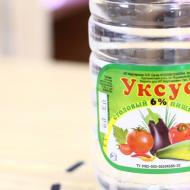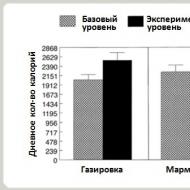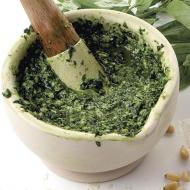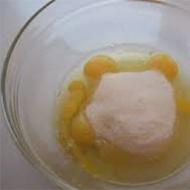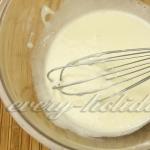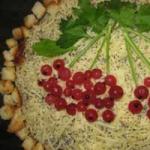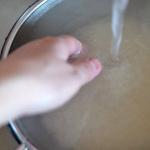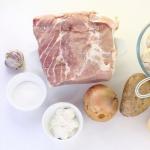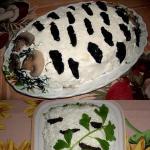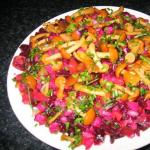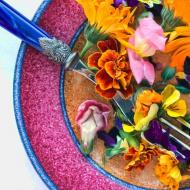
Japanese Castella sponge cake with honey. What is the difference between Japanese castella and Western sponge cake How to prepare Japanese sponge cake
Many Japanese sweets are served with matcha, a green tea that has a bitter taste, so they are made sweet enough to create a harmonious taste. Biscuit is no exception, which some find very sugary. But still, it has its own charm, and many people like it.What is Japanese biscuit
The Japanese call this sponge cake kasutera, which is a Japanese adaptation of the word castella. Perhaps this word comes from the word Castilla - the name of a part of Spain. The dish itself was introduced to Japan in the 16th century by Spanish and Portuguese missionaries and merchants. Since the biscuit was first brought through the port of Nagasaki, it was believed for a long time that the best version of this sweet was prepared here. Soon the Japanese adapted it to their taste, and it ceased to look like an ordinary sponge cake as we are used to seeing it.After some time, kasutera ceased to be a sweet only in Nagasaki and became widespread throughout all corners of the country. And not only as a dessert, but also as a nutritious dish for people weakened by illness. Often this biscuit is served for an afternoon snack or after the main meal. You can easily take it with you as a gift to your hosts if you are invited to visit. Kasutera is sold in many stores in Japan.
The main distinguishing qualities of kasutera are its pronounced egg aroma and slightly moist structure.

How to cook Japanese sponge cake
Let us present to your attention a classic recipe for Japanese sponge cake, and its ingredients are quite affordable. To prepare four servings you will need:- Wheat flour – 70 grams.
- Chicken eggs – 2 pieces.
- Sugar – 50 grams.
- Honey - two tablespoons.
- Water or milk – 30 ml.
- Salt - a pinch.
- Sugar for sprinkling the bottom of the baking dish - one tablespoon.

Cooking process
Beat the eggs in a bowl and then add all the sugar. Place this bowl in a larger container, where you have previously heated the water to 50 degrees, and in such a bath carefully mix the mixture. In a separate cup, stir water or milk with honey and add to the eggs.
Salt the flour, sift and add to the egg mixture three or four times, stirring with a wooden spatula. Pour the finished mixture into the mold you made at the beginning. Heat the oven to 160 degrees and bake the biscuit on the lower tier. If the dough browns too quickly, cover the top with foil.
Differences between regular sponge cake and kasuterA
There is an opinion that the most delicious kasuteru can be prepared only in small quantities, so the Japanese prefer to buy this dessert in small cafes and shops, where one worker is responsible for the entire baking process. Japanese biscuit is baked in rectangular or square tins and then cut into pieces.
A real kasutera sponge cake should be moist and dense. If you leave it for up to two days, the cake will become even more moist and dense. While the task of the confectioner preparing a European sponge cake is to make it as airy and light as possible.
When preparing Japanese sponge cake, baking powder is not used, and a large number of air bubbles and porosity are achieved by thoroughly beating with a mixer. Another factor that allows you to maintain the structure of the dough is a lot of sugar, which is why some people don’t like this biscuit. Sugar also contributes to the formation of casutera's characteristic dark crust.
Moreover, not just one sugar is added to the Japanese sponge cake, but three: mizuame, regular white granulated sugar and bee honey. Everything is clear with honey and sugar, but what is mizuame? This is a special type of syrup that is obtained by converting starches into sugars. The Japanese have been using this syrup in sweets since ancient times, when they did not yet know about the existence of sugar. This syrup also adds moisture to the cake. In some recipes, mirin sweet rice wine is added to kasutera.

In order to get a real high-quality European sponge cake, only flour containing a minimum amount of gluten is added to the dough. While for Japanese sponge cake you can use flour with either low or high gluten content, or both at the same time in different proportions.
So, if you eat a very sweet, dense sponge cake with a honey aroma, this is kasutera. It cannot be confused with a classic airy sponge cake.
Try making this dessert for the whole family. Here is one of the Japanese recipes, which is available to us in terms of products and you don’t have to run around the shops getting exotic ingredients.
Video on the topic of the article
Anyone who has tried Japanese sponge cake at least once in their life will agree that this product is worthy of special attention. Created many centuries ago, it is still very popular not only in its own country, but also abroad.
Honey "Castella"
Originally, Japanese sponge cake was made from eggs, sugar, flour and starch syrup. Over the years, the composition of the dessert has changed due to the special food preferences of the inhabitants of this country. Over time, Europe began to appreciate the taste of this extraordinary dish. Today, any housewife can please her household and prepare an original Japanese sponge cake using the following basic ingredients: 8 eggs, 100 grams of milk, 300 grams of brown sugar, 200 grams of flour and 150 grams of honey.
This dessert is easy to prepare:
- First you need to sift the measured amount of flour. The procedure must be repeated three times so that the product can be “saturated” with oxygen as much as possible.
- Dilute honey in milk until completely dissolved.
- Beat eggs with sugar. The process must be carried out in a water bath for 15 minutes. During this time, the temperature of the mass should reach 60 degrees.
- Place the egg mixture in the bowl of a food processor and continue beating until it has completely cooled.
- Pour milk with honey dissolved in it.
- Gradually add flour without stopping stirring.
- Cover the mold with parchment and then pour the prepared mixture into it.
- Excess air must be removed from the mixture. To do this, you need to hit the form once on the table.
- The biscuit should be baked in the oven at 180 degrees for 50 minutes.
- Place the finished product in a plastic bag and refrigerate for several hours. This is necessary so that it becomes more moist and dense.
The finished biscuit is cut into small rectangles. In order not to damage the structure of the product, it is better to do this with a sharp knife with a grooved blade.
The history of the popular biscuit in Japan dates back to the 16th century. It was then that merchants from Portugal first landed off the coast of Nagasaki Island. Along with tobacco, guns and various provisions, they brought with them a very tasty biscuit. Local residents liked the unusual product. It began to be called “bread from Castile”, and for short - “castella”. But in those days, it was not so easy for the Japanese to prepare it themselves due to the high prices for sugar in the country. That is why local chefs began to develop new recipes for the production of “overseas delicacies”. This is probably why the country still believes that the most delicious Japanese biscuit is baked in Nagasaki. Today this dish is popular in many countries around the world. True, it is prepared mainly at home or in small bakeries. Making castella on a production scale is very difficult. This product is very capricious and sensitive to any changes in humidity or temperature.
Original base
The famous oriental biscuit is good not only for tea. It can be an excellent base for preparing other desserts. But first you need to bake the Japanese sponge cake itself. The recipe for its preparation is, in principle, simple. To work, you will need the following set of products: for 130 milliliters of milk - 85 grams of flour, 70 grams of butter, 80 grams of sugar, food coloring (if desired), 1 chicken egg, and another 165 grams of whites and 120 grams of yolks.

The method of preparing the product includes the following stages:
- Pour milk into a saucepan and put butter in it. Place the container on the fire and bring its contents to a boil.
- Stirring constantly, slowly add flour and boil the dough.
- Preheat the oven to 170 degrees.
- Transfer the finished dough into a food processor and mix slightly until it cools.
- Add egg and yolks. If you plan to make a colored sponge cake, then the dye should be introduced at this stage.
- Separately, beat the whites with sugar with a mixer.
- Connect both masses. You need to work with a regular spatula.
- Then beat the resulting mixture with a food processor for 2 minutes.
- Line a baking tray with special baking paper.
- Pour the mixture into a thin layer and place in the oven for 15 minutes.
The result is a thin, delicate and very soft sponge cake that can remain that way for several days.
homemade baking
For novice housewives, we can offer a simplified version. By following the simplest steps, they can get a real Japanese sponge cake. The recipe is extremely simple and only requires the following ingredients: for 2 eggs - 70 grams of flour, a pinch of salt, 2 tablespoons of water (or milk) and honey, 63 grams of sugar (including 13 grams for sprinkling the mold).
Operating procedure:
- If there is no special mold in the house, then you can make it yourself. You must first build a rectangular box from thick paper. The outside must be wrapped in foil, and the inside must be lined with clean paper.
- Beat eggs in a deep bowl.
- Gradually add sugar to them.
- Place the container in a saucepan with water heated to 50 degrees and mix its contents thoroughly again.
- Separately, dilute the honey with water (or milk), and then add it to the egg mixture.
- Combine salt with flour. Add the dry ingredients into the container, portionwise, stirring the contents with a wooden spatula.
- Pour the mixture into a prepared form and bake in the oven at 160 degrees. Check readiness with a wooden stick or toothpick.
For better baking, the pan should be placed on the bottom shelf. If the surface of the biscuit turns brown very quickly, you can cover it with a piece of foil.
Chiffon biscuit
In cooking, there is another option for preparing a biscuit with a similar consistency. It was created much later, in 1927, and was called “chiffon”. For comparison, consider this sponge cake recipe. In the oven, regular muffin tins are often used to bake it. True, in this case the composition of the ingredients will be different: for 200 grams of flour - 2.5 teaspoons of baking powder, 5 eggs (plus 1 more white), 210 grams of sugar, 135 milliliters of water, 5 grams of salt, 2 grams of citric acid and 90 milliliters of olive oil.

Cooking method:
- The first step is to preheat the oven. The temperature inside it should be from 160 to 170 degrees.
- Then you need to break the eggs, separating the yolks from the whites.
- Pour the sifted flour into a deep bowl.
- Add the rest of the dry ingredients (salt, sugar and baking powder) there.
- Make a depression in the middle of the “slide”, and then pour water with oil and yolks into it. Beat them in with a whisk for 1 minute until the mixture becomes homogeneous.
- In another container, use a mixer to turn the whites into a dense foam.
- Gradually add citric acid and sugar to them. You need to beat for a long time until you get characteristic peaks.
- Fold the whites into the egg mixture little by little.
- Pour the finished dough into the mold and place it in the oven for 50 minutes.
Many people prefer this particular biscuit recipe. In the oven it turns out very soft and fluffy. In addition, the product cuts perfectly and does not even crumble.
Alternative option
There is another recipe with which you can also make an excellent Castella sponge cake. To do this you will need: one and a half glasses of flour, 7 eggs (plus 3 more yolks), 50 grams of any vegetable oil (flavorless), 75 grams of honey, 5 grams of salt and 300 grams of sugar.

The process of preparing such a biscuit is somewhat similar to that used in the previous versions:
- Pour the pre-sifted flour into a bowl along with salt.
- Beat the remaining ingredients (except for the oil) with a mixer in another bowl.
- Place this container in a pan of boiling water and continue whisking for 10 minutes. The sugar should dissolve completely.
- Gently fold in the flour.
- Separate part of the dough and grind it with butter, then return it back and make the final knead.
- Transfer the mixture into the mold.
- Bake for 15 minutes in the oven at 170 degrees.
- Make the flame smaller. Continue baking for another 45 minutes at 150 degrees.
It is better to cool such a biscuit directly in the mold.
Chocolate treat
Those who like the aroma of cocoa can prepare an oriental-style chocolate dessert at home. To ensure that the taste of the finished product is close to the original, you need to prepare the sponge cake in Japanese style. The following composition is suitable for this:
105 grams of eggs and 15 grams of yolks only, 10 grams of whole milk, glucose (or liquid honey) and cocoa powder, 80 grams of sugar, 25 grams of corn oil, 50 grams of flour, a pinch of salt, soda and vanillin.

Cooking method:
- First, you need to heat the butter, and then add cocoa to it and mix.
- Pour in milk.
- Add salt and vanilla. After stirring, wait until the mixture has cooled completely.
- Separately, beat the eggs with honey, adding the yolks.
- Without stopping, add sugar little by little. You should get an airy foam mass. But they shouldn't be. Therefore, stirring must be continued with a hand whisk.
- Add cocoa butter to the prepared mixture.
- Add flour slowly, stirring thoroughly so that no lumps remain.
- Pour the dough into a mold lined with parchment.
- Bake for 5 minutes in the bottom of the oven at 170 degrees. After this, you need to move the form a little higher and wait another 27 minutes.
After cooling, the finished dessert can be eaten. If you pour soft cream over it, you will get a wonderful cake.
Delicacy of cotton
In small cafes, the Japanese often serve the most delicate dessert with a wonderful silky texture. It is sometimes called "cotton". Japanese puffed sponge cake is prepared here from the following products: 3 eggs, 225 grams of cream cheese, zest of half a lemon, 100 grams of cream (10%) and sugar each, a teaspoon of vanilla, 30 grams of flour and rice starch.

Cooking process:
- Wrap the outside of the baking dish with foil. The inside should be coated with oil and covered with thick paper.
- Preheat the oven to 180 degrees.
- Boil one and a half liters of water.
- Divide the eggs into yolks and whites.
- Bring the cream to a boil in a saucepan.
- Grind some of the sugar with the yolks until white.
- Add hot cream in a thin stream.
- Mash the cheese and add it in parts to the egg mixture. Whisk until smooth.
- Use a mixer to turn the whites into foam. Without stopping stirring, add sugar.
- Add starch, flour, vanilla and zest to the creamy mixture.
- Add egg whites and sugar gradually.
- Transfer the dough into the mold. In order for large air bubbles to come out of it, the container must be lifted and sharply hit on the table.
- Bake in the oven in a water bath for 5 minutes.
- Reduce temperature to 160 degrees and wait another 45-55 minutes. The finished biscuit should spring back in the center.
- Turn off the fire. Remove the pan from the water bath and leave it to cool in the oven with the door open.
In just 40 minutes the dessert will be ready to eat.
I have repeatedly been convinced that weighing out food in advance is much more convenient than rushing around the kitchen in search of something urgently needed. So let's do everything ahead of time! Place 2 eggs of category 1 in a separate cup. To the other - dry and clean! - 3 whites from category 1 eggs. If your eggs are different, focus on grams - there should be from 100 to 110 g of protein.
Place 90 g of milk and 50 g of butter 82.5% into a saucepan.

Sift 60 g of flour into a separate dry bowl. Add a pinch of salt and mix.

And in another bowl - 60 g of sugar.

Let's make the dough!
Place a saucepan with milk and butter on the stove over medium heat, heat until the butter melts. Then immediately remove from heat and add flour.

Mix well with a whisk. And return to the fire.

Stirring constantly, cook until a thin film forms on the bottom of the pan. It literally takes me a couple of minutes.

Remove from the onion and transfer the mixture to a clean bowl.

Mix with a mixer using a hook attachment. During this time, the dough should cool slightly and steam will stop flowing.

Add eggs one at a time and mix thoroughly.

This is the consistency.

Add dye. I have a water-soluble gel.

Mix everything well again.

Separately, beat our egg whites with sugar until they do not fall out of the inverted bowl. As for .

Little by little, add the whipped whites to the custard mixture.

Using a silicone spatula, carefully fold in the whites from bottom to top. As when kneading dough for, again, . Here's what happens. Of course, the color immediately fades.

Our dough is ready.

Let's bake!
And now - very important! Before pouring the dough onto a baking sheet, line it with high-quality baking paper and be sure to grease it with vegetable oil! Otherwise, you will never get your finished Japanese custard cake off the baking sheet or paper! Tested by me personally (I haven’t tried using silicone or Teflon mats, I’ll say right away. But, given my experience, I would grease them too) Just in case) I have a baking tray measuring 30x35. The biscuit turned out to be 5-7 mm thick. I baked it just for the “tightness”, not too thin. Focus on this data when you bake your biscuit. Distribute the dough on the baking sheet as evenly as possible. Considering that we are applying it to vegetable oil, this will not be so easy to do, but... we will have to! For example, this wide spatula for leveling cakes will help us with this.

You can walk on top with a spatula. In general, all means are good! The main thing is to get as even a layer of dough as possible!

Place in an oven preheated to 180 degrees for about 15 minutes. Your oven may need less time! Do not open the door right away! But after 10 minutes you can check how your biscuit is doing: poke a dry splinter into the middle or simply press with your finger. If ready, the splinter will come out dry, and the surface will be non-sticky and springy. We take out the biscuit and immediately remove it from the baking sheet! Place it on the table or, like me, on a damp towel.

Let it cool and carefully - the sponge cake, although elastic, is tender! - remove from parchment. It comes off very well after vegetable oil! But if you don’t lubricate it, consider it all, your efforts were in vain! I’ll have to redo it, I’m telling you for sure!

And here’s a closer look at our biscuit) Do you see what it’s like? Porous, spongy, so pleasantly rubbery) In texture, not in taste! It tastes just tender and melting!

I really like how this porosity plays in combination with the bright green color. Ideal for garden or forest themed cakes. And even slightly baked places look very organic. However, you can carefully remove them with a thin knife if your idea and color are different and even small scorch marks are “off topic.” Well, or, as an option, watch the oven very carefully. I’ve already complained to you about mine: if you bake it in the middle until done, then the edges will certainly be too much (But this time I’m very happy with how it turned out!

They asked how the classic “European” sponge cake differs from the traditional Japanese Castella sponge cake. For some, the word “Castella” will mean nothing at all, but if you come to Japan at least once, you will probably see it somewhere. This Japanese sponge cake really has a distinctive look and taste, so it's hard to mistake it for something familiar when you see or eat it for the first time.
Castella was brought to Japan by the Portuguese via Nagasaki in the sixteenth century. Therefore, it is traditionally believed that the most delicious and authentic Castella can be baked there. Of course, during my trip to Nagasaki, I also succumbed to the herd instinct and brought Castella from there for Lesha. When we met, I, in a sense, became his window to Japan, because I am, after all, a Japanese specialist, and he came here simply for work, without knowing the language, and at first he had a vague idea of where he ended up :)
Then I did not have the impression that Castella from Nagasaki was in any way very different from the one baked in good pastry shops with traditional Japanese sweets in Kobe. After all, you don’t need to have any strict geographical reference to learn how to bake delicious biscuits from widely available products over the course of four centuries. And the migration of people has reached such a scale that today you bake biscuits in one country, and tomorrow in another.
How do these two types of biscuits differ from each other? Classic sponge cake is very light and airy, Castella is denser and moister. This difference is achieved due to differences in the list of ingredients and dough preparation technology.
There are several ways to prepare sponge cake: in some, the whites are whipped separately from the yolks, in others, together. If the eggs are beaten with a mixer, then in the process of mixing the whipped whites into the total mass and combining with flour, it is very important not to overmix the dough, otherwise it will lose volume and gluten, which is unnecessary in this case, will begin to be released from the flour, which will make the sponge cake rubbery and dense. Therefore, mix the flour carefully with a spatula and stop immediately as soon as the dough becomes homogeneous, without lumps of flour. Baking powder is also used to add airiness.
In Castella, baking powder is not used because it will make the dough too airy and light. The dough is thoroughly beaten with a mixer, as a result of which many air bubbles are formed in it, which are enough to make the dough porous. They add more sugar to Castella (and that’s why I personally don’t like it very much - it’s too cloying). Sugar also helps maintain the structure of the whipped dough, and the bubbles do not “dissolve” until the end of baking. The high sugar content helps to achieve the characteristic dark crust.
Here we can summarize with a dry excerpt from the theory. There are only three ways to make the dough rise.
1. Physical by beating and enriching the dough with air.
2. Chemical using baking powder and similar substances.
3. Biological using yeast.
Biscuit and Castella use two of the three methods.

In addition, not just sugar is added to Castella, but three types of sugar: white, mizuame and honey. Mizuame is a sweet syrup that was historically used in Japanese sweets back in the days when the Japanese had never seen white sugar. This syrup is made by converting starch into sugar. As far as I understand, this technology is similar to the technology for making corn syrup, which is so popular these days. In particular, thanks to syrup and honey, the texture of Castella ultimately turns out dense and moist. The honey aroma and some sweetness will immediately tell you that you are not eating a classic European sponge cake. Mirin, a sweet rice wine, is also often added to Castella. I don’t know if the comparison is correct, but our homemade honey “pies” are also somewhat similar in texture to Japanese Castella, their density is comparable.
For classic biscuits, “weak” flour with a low gluten content is always used. For Castella, both “weak” and “strong” flour are used, as well as a combination of them in different proportions.

It is believed that truly tasty Castella is difficult to make in industrial quantities, because it is very capricious to changes in temperature and humidity. Therefore, the most delicious Castella is sold in small shops, where one person is responsible for the full cycle of production and baking. It is usually baked in rectangular or square shapes and then cut into rectangles. Aging is beneficial for the cakes - one or two days after baking they become even denser and moist.
And here is a roll that is sold in one of our supermarkets. It is very tasty and reminds me of Soviet biscuits layered with apple jam. For some reason :) Although the filling here uses whipped cream with sweet red beans - a Japanese classic (sweet beans, not cream :)). The roll is unusual in that usually Castella is still a sponge cake as it is, without fillings or additives.

Something like this, if briefly about how Castella differs from European sponge cake in terms of ingredients and cooking technology. From a practical point of view, I can’t say anything, because I’ve never cooked Castella myself. But as a sponge cake for a cream roll, I liked it much more than on its own, and in this version it makes me much more interested in making something similar with my own hands one day.
Castella is a popular biscuit in Japan, the recipe of which is already 5 centuries old. Moist, heavy, with the aroma and taste of honey, it is bright yellow inside and covered with a brown crust on top. Baking owes such an appetizing top to the large amount of sugar in the dough.
How castella biscuits ended up in Japan - an interesting history of ancient baking
Honey sponge cake, reminiscent of our Easter cakes, was brought to the land of the rising sun by Portuguese traders. Back in the 16th century, ships brought various strange goods from Portugal, including sweets. Europeans could trade only in Nagasaki. From this port the food gradually spread throughout all the islands.
Many months of Portuguese sailing across the seas did not spoil castella - bread from Castile. The Japanese, who tasted the overseas treat, liked the taste of the dish. And they began to bake such sweet bread themselves. At that time, sugar was very expensive. We have already written about this in. Due to the high cost of granulated sugar, the Japanese castella sponge cake was considered a delicacy for the elite. One of the famous wealthy samurai once presented it as a gift to the emperor himself as a sign of the great honor and respect that he and his family had for the ruler of Japan.
What is Japanese castella made from?
The dessert is baked at a temperature of 160-180 degrees for 35-40 minutes. The composition of the baked goods is simple and accessible. This is a large number of chicken eggs, sugar, sweet starch syrup, honey, flour. Honey gives sweets a unique characteristic taste and aroma that cannot be confused. Those who have once tasted a Japanese treat will find it easy to recognize it from all the others. For those who want to drink tea with a Japanese accent, we suggest making the overseas sweet yourself. There is nothing difficult in the process. You just need to familiarize yourself with the simple features.
What is the difference between Japanese castella sponge cake and ordinary European one?
There are differences and they are obvious :
- Compound: Add a small amount of honey and starch-based syrup to the base. These ingredients are responsible for the taste, aroma and consistency of baked goods.
- Cooking technology: beat the egg-sugar mass with a mixer at high speed for 5-10 minutes. Then honey and mizuame syrup are added. This starch syrup was prepared back in the days when sugar in Japan was available only to a select few and cost incredible amounts of money.
Beat the egg mixture with sugar and mizuame for another 3-5 minutes. Flour is poured in three additions. Before this, it is sifted three times. Thanks to this simple manipulation, the dough acquires the necessary fluffiness.
Baking powder is never used so as not to make the castella sponge cake too airy and light. The recipe for authentic baking does not require baking powder.
- Form: must be rectangular. Before baking, it is greased with vegetable oil, covered with parchment, and only after these manipulations the dough is poured. Then the base is compacted so that excess air escapes from the base. To do this, shake the container with the dough slightly or tap it on the table two or three times. Some people draw strokes on the dough with a long wooden skewer.
Cool the baked goods, wrapped in cling film, immediately after removal from the mold, in the refrigerator for one to two days.
This is how the baking acquires the necessary moisture, as in. The hot product is immediately placed in a film so that the hot steam escaping from it immediately returns back. This way the dessert becomes moist enough and can be stored for up to five days.
- Innings: castella is served cut into rectangles 12 by 3 cm.


